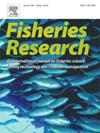Assessing narrow and composite Nordmøre-grid bar spaces in southeastern Australian penaeid trawls
IF 2.3
2区 农林科学
Q2 FISHERIES
引用次数: 0
Abstract
Owing to concerns over unwanted mortalities of fish in a southeastern Australian trawl fishery targeting school prawns, Metapenaeus macleayi (∼13–25 mm carapace length; CL), three experiments were done to quantify the effects on species- and size-selectivity due to reducing bar spaces throughout Nordmøre-grids (405 × 848 mm), and in the upper section only (405 × 424 mm; ‘composite grids’). In all experiments, a conventional grid comprising 20-mm bar spaces was the control. During experiment 1, trawls with treatment grids comprising either 18- or 16-mm spaces (i.e. close to the maximum heights of the largest school prawns) caught similar quantities of school prawns as the control, and while there were no significant catch or size effects, mean incidental catches of fish were incrementally lower in trawls with the 18- (by 12 %) and 16-mm grids (by 46 %). In the second experiment, two composite grids comprising 20-mm spaces in the lower section and either 16 or 14 mm in the top (16/20- and 14/20-mm grids) were fished against the control. Only the 14/20-mm grid significantly reduced the catches of school prawns (by 17 % across all sizes) and the weight of incidental catch (by 46 %). The 16/20- and 16-mm grids were then compared in trawls against the control during experiment 3 to inform likely species-specific vertical orientations anterior to the grid. There were no significant effects on school prawn catches or sizes (although mean weights were lower for the 16- than 16/20-mm grid), but the weights of incidental fish catches were similarly and significantly lower for both narrower-spaced grids (by 50 and 57 %). The data imply bar spaces in regional Nordmøre-grids can be reduced to widths ∼1 mm larger than the maximum carapace dimensions (height) of the largest school prawns, and in the top section to maximise species selectivity. Similar configurations may apply to other trawl fisheries targeting penaeids.
评估澳大利亚东南部对虾拖网中狭窄的和复合的nordm ø重新栅格杆空间
由于担心在澳大利亚东南部拖网渔业中以鱼群对虾为目标的鱼类意外死亡,麦莱氏Metapenaeus macleayi(~ 13-25 毫米甲壳长度;在整个nordm øre-grid(405 × 848 mm)和仅在上部区域(405 × 424 mm)减少棒间距对物种和尺寸选择性的影响;“复合网格”)。在所有的实验中,一个由20毫米bar空间组成的传统网格作为对照。在实验1中,采用18或16毫米空间(即接近最大群虾的最大高度)的处理网格的拖网捕获的群虾数量与对照相似,虽然没有显著的渔获量或大小效应,但18-(减少12% %)和16毫米网格的拖网的平均偶然渔获量逐渐减少(减少46% %)。在第二个实验中,将两个复合网格(16/20和14/20-mm网格)作为对照,其中下部为20毫米空间,顶部为16或14 毫米空间。只有14/20毫米栅格显著减少了群虾的捕获量(所有尺寸均减少了17% %)和偶然捕获的重量(减少了46% %)。然后,在实验3中,将16/20和16毫米网格与对照在拖网中进行比较,以了解网格前方可能的物种特异性垂直方向。对群虾的渔获量或大小没有显著影响(尽管16/20毫米栅格的平均体重比16/20毫米栅格的平均体重低),但两种较窄栅格的偶然渔获重量相似且显著降低(分别降低50%和57% %)。数据表明,区域nordm ø重新网格中的条形空间可以缩小到比最大群对虾的最大外壳尺寸(高度)大1 毫米的宽度,并且在顶部部分可以最大限度地提高物种选择性。类似的配置可能适用于以对虾为目标的其他拖网渔业。
本文章由计算机程序翻译,如有差异,请以英文原文为准。
求助全文
约1分钟内获得全文
求助全文
来源期刊

Fisheries Research
农林科学-渔业
CiteScore
4.50
自引率
16.70%
发文量
294
审稿时长
15 weeks
期刊介绍:
This journal provides an international forum for the publication of papers in the areas of fisheries science, fishing technology, fisheries management and relevant socio-economics. The scope covers fisheries in salt, brackish and freshwater systems, and all aspects of associated ecology, environmental aspects of fisheries, and economics. Both theoretical and practical papers are acceptable, including laboratory and field experimental studies relevant to fisheries. Papers on the conservation of exploitable living resources are welcome. Review and Viewpoint articles are also published. As the specified areas inevitably impinge on and interrelate with each other, the approach of the journal is multidisciplinary, and authors are encouraged to emphasise the relevance of their own work to that of other disciplines. The journal is intended for fisheries scientists, biological oceanographers, gear technologists, economists, managers, administrators, policy makers and legislators.
 求助内容:
求助内容: 应助结果提醒方式:
应助结果提醒方式:


